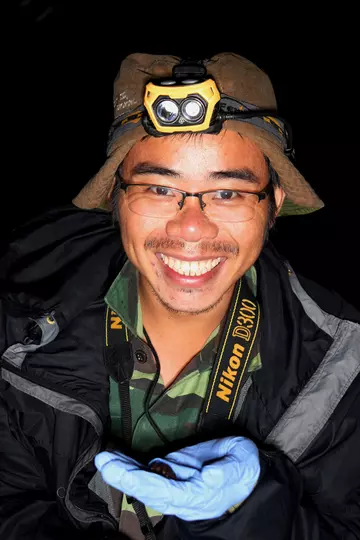
Frogs in Vietnam
Little is known about the distribution, ecology, status and population trends of many amphibian species, especially in Southeast Asia 1. This knowledge gap hampers conservation efforts and conservation prioritisation. While a lack of baseline data makes it difficult for conservation practitioners to assess whether a particular conservation intervention has had the desired impact.
Our international team made up of specialists from ZSL, the Asian Turtle Program of Indo-Myanmar Conservation and the Australian Museum have been working in the Hoang Lien Range in northwest Vietnam since 2015. The range is one of most important areas for amphibian diversity and in mainland Southeast Asia and home to more than 80 amphibian species, but habitat across the mountain range is being lost or seriously degraded 2. We trained a team of researchers from Hoang Lien National Park and began monitoring amphibians and their pathogens in 2015.
Protecting newly described species
Our work has focused on Sterling’s toothed toad (Oreolalax sterlingae) and Botsford’s leaf-litter frog (Leptobrachella botsfordi). Both were described from the same, high elevation stream site in Hoang Lien National Park on Mount Fansipan, Vietnam’s highest mountain in 2013 3-4. These frogs are associated with rocky rivulets and streams that flow through bamboo and elfin forest 3-6. Shortly after their description, both species were assessed as Critically Endangered by our team as the only site that they were known to occur was increasingly threatened by habitat loss and pollution associated with tourists and infrastructural developments associated with tourism 2, 7-9.
Since Sterling’s toothed toad was described, our team have described the tadpole of this species 10 and recorded it at another site 20 km away on Mount Pu Ta Leng 5. As a result, the species was subsequently reassessed as Endangered in 2021 8. Since Botsford’s leaf-litter frog was described, our team has gained new insight into the reproductive biology of the species; we have described the tadpole, oviposition sites and egg clutch attendance 6,7. Tadpoles, associated with gravel substrates, and gravel is mined from streambeds within Hoang Lien National Park 7. We recently recorded this species from Mount Nam Kang Ho Tao 23.4 km southeast of the closest reported location of the species on Mount Fansipan 6. Botsford’s leaf-litter frog has an elevation range of 2578–2815 m a.s.l. 7 and still qualifies for being assessed as Critically Endangered 7.
Largest survey of amphibian chytrids in mainland Southeast Asia
Other outputs of our work the scientific description of five new megophryid frogs new to science 11-14 and the largest site-based survey of amphibian chytrids completed to date in mainland Southeast Asia 15. We have assessed or reassessed 14 other amphibians (including three of the species we described) in the Hoang Lien Range 16-30 and have submitted Green Status assessments for Botsford’s leaf-litter frog and Sterling’s toothed toad. We have built local conservation and research capacity via training workshops for Hoang Lien National Park staff and by supporting a local conservation Biologist (Luan Thanh Nguyen) via an EDGE Fellowship and subsequent EDGE Hero award focused on Botsford’s leaf-litter frog.

The future of Botsford’s leaf-litter frog and Sterling’s toothed toad is dependent on strict protection of remaining habitat and ensuring that no further degradation occurs at the sites where they are known to be present. We are working with Hoang Lien National Park and other stakeholders to protect these key sites.
1. Rowley, J.J.L, Brown, R., Bain, R., Kusrini, M., Inger, R., Stuart, B., Wogan, G., Neang, T., Chan-ard, T., Trung, C.T., Diesmos, A., Iskandar, D.K., Lau, M., Ming, L.T., Makchai, S., Nguyen, T.Q., Phimmachak, S. (2010). Impending conservation crisis for Southeast Asian amphibians. Biology Letters, 6:336–338.
2. Tapley, B., Rowley, J.J.L., Nguyen, C.T., Luong, H.V. (2017). A conservation action plan for the amphibians of the Hoang Lien Mountain range, accessed 9th January 2023.
3. Nguyen, T.Q., Phung, T.M., Le, M.D., Ziegler, T., Böhme, W. (2013). First record of the genus Oreolalax (Anura: Megophryidae) from Vietnam with description of a new species. Copeia, 2:213–222.
4. Rowley, J.J., Dau, V.Q., Nguyen, T.T. (2013). A new species of Leptolalax (Anura: Megophryidae) from the highest mountain in Indochina. Zootaxa, 3737: 415–428.
5. Tapley, B., Nguyen, L.T., Portway, C., Cutajar, T., Nguyen, C.T. Luong, H.V., Kane, D., Harding, L., Rowley, J.J.L. (2020). A point endemic no more; a range extension for Oreolalax sterlingae (Nguyen et al., 2013) in Bat Xat District, Lao Cai Province, northern Vietnam. Herpetology Notes, 13: 497–500.
6. Nguyen, L.T., Rowley, J.J.L. La, T.V., Tapley, B. (2023). Notes on the oviposition sites of Botsford’s leaf-litter frog (Leptobrachella botsfordi) and a significant range extension for the species. Herpetology Notes, In Press.
7. Nguyen, L.T., Tapley, B., Cutajar, T., Nguyen, C.T., Portway, C., Harding, L., Van Luong, H., Rowley, J.J.L. (2020). A description of the tadpole of the Critically Endangered Botsford’s leaf-litter frog (Leptobrachella botsfordi) with comments on the distribution and conservation status of the species. Zootaxa, 4860: 293–300.
8. IUCN SSC Amphibian Specialist Group (2021). Oreolalax sterlingae. The IUCN Red List of Threatened Species 2021: e.T76491633A87995169. Accessed on 9 January 2023.
9. IUCN SSC Amphibian Specialist Group (2021). Leptobrachella botsfordi. The IUCN Red List of Threatened Species 2021: e.T73727195A87994974. https://dx.doi.org/10.2305/IUCN.UK.2021-3.RLTS.T73727195A87994974.en. Accessed on 9 January 2023.
10. Rowley, J. J., B. Tapley, N. T. Chung & R. Altig (2017): Tadpole of the Critically Endangered Sterling’s Toothed Toad (Oreolalax sterlingae). – Zootaxa, 4272: 579–582.
11. Nguyen, L.T., Tapley. B., Nguyen, C.T., Rowley, J.J.L. 2021. A new species of Leptobrachella (Anura, Megophryidae) from Mount Pu Ta Leng, northwest Vietnam. Zootaxa 5016: 301-332.
12. Tapley, B., Cutajar, T., Nguyen. L.T., Portway, C., Mahony, S., Nguyen, C.T., Harding, L., Luong, H.V., Rowley, J.J.L. 2021. A new potentially Endangered species of Megophrys from Mount Ky Quan San, northwest Vietnam. Journal of Natural History 54: 2543-2575
13. Tapley, B., Cutajar, T., Mahony, S., Nguyen, C.T., Dau, V.Q., Luong, A.M., Le, D.T., Nguyen, T.T., Nguyen, T.Q., Portway, C., Van Luong, H., Rowley, J.J., 2018. Two new and potentially highly threatened Megophrys Horned frogs (Amphibia: Megophryidae) from Indochina’s highest mountains. Zootaxa, 4508: 301-333.
14. Tapley, B., Cutajar, T., Mahony, S., Nguyen, C.T., Dau, V.Q., Nguyen, T.T., Van Luong, H., Rowley, J.J., 2017. The Vietnamese population of Megophrys kuatunensis (Amphibia: Megophryidae) represents a new species of Asian horned frog from Vietnam and southern China. Zootaxa, 4344: 465-492.
15. Tapley, B., Jervis, P., Nguyen, L.T., Portway, C., Nguyen, C.T., Luong, H.V., Kane, D., Brookes, L., Perkins, M.W., Ghosh, P., Wierzbicki, C., Shelton, J., Fisher, M.C., Rowley, J.J.L. 2020. Low prevalence of Batrachochytrium dendrobatidis detected in amphibians from Vietnam’s highest mountains. Herpetological review. 51 (4): 726-732.
16. IUCN SSC Amphibian Specialist Group. 2022. Amolops daorum. The IUCN Red List of Threatened Species 2022: e.T58585A48102482. Accessed on 11 December 2022
17. IUCN SSC Amphibian Specialist Group. 2022. Odorrana chapaensis. The IUCN Red List of Threatened Species 2022: e.T58204A63854396. Accessed on 11 December 2022.
18. IUCN SSC Amphibian Specialist Group. 2022. Theloderma bicolor. The IUCN Red List of Threatened Species 2022: e.T59032A98359374. Accessed on 11 December 2022.
19. IUCN SSC Amphibian Specialist Group. 2022. Megophrys maosonensis. The IUCN Red List of Threatened Species 2022: e.T114116699A114116708. Accessed on 11 December 2022.
20. IUCN SSC Amphibian Specialist Group. 2022. Megophrys daweimontis. The IUCN Red List of Threatened Species 2022: e.T57635A63857337. Accessed on 11 December 2022.
21. IUCN SSC Amphibian Specialist Group. 2022. Zhangixalus dorsoviridis. The IUCN Red List of Threatened Species 2022: e.T112692905A112692922. https://dx.doi.org/10.2305/IUCN.UK.2022-1.RLTS.T112692905A112692922.en. Accessed on 31 July 2022.
22. IUCN SSC Amphibian Specialist Group. 2022. Amolops ottorum. The IUCN Red List of Threatened Species 2022: e.T173312783A173330500. https://dx.doi.org/10.2305/IUCN.UK.2022-1.RLTS.T173312783A173330500.en. Accessed on 31 July 2022.
23. IUCN SSC Amphibian Specialist Group. 2022. Megophrys palpebralespinosa. The IUCN Red List of Threatened Species 2022:e.T57650A63854984. https://dx.doi.org/10.2305/IUCN.UK.2022-1.RLTS.T57650A63854984.en. Accessed on 31 July 2022.
24. IUCN SSC Amphibian Specialist Group. 2022. Megophrys hoanglienensis. The IUCN Red List of Threatened Species 2022:e.T150087100A150087105. https://dx.doi.org/10.2305/IUCN.UK.2022-1.RLTS.T150087100A150087105.en. Accessed on 31 July 2022.
25. IUCN SSC Amphibian Specialist Group. 2021. Megophrys fansipanensis. The IUCN Red List of Threatened Species 2021: e.T150087086A150087092. https://dx.doi.org/10.2305/IUCN.UK.2021-3.RLTS.T150087086A150087092.en.
26. IUCN SSC Amphibian Specialist Group. 2021. Megophrys rubrimera. The IUCN Red List of Threatened Species 2021: e.T145401778A151592091. https://dx.doi.org/10.2305/IUCN.UK.2021-3.RLTS.T145401778A151592091.en.
27. IUCN SSC Amphibian Specialist Group. 2021. Gracixalus sapaensis. The IUCN Red List of Threatened Species 2021: e.T114139578A114139584. https://dx.doi.org/10.2305/IUCN.UK.2021-3.RLTS.T114139578A114139584.en.
28. IUCN SSC Amphibian Specialist Group. 2021. Megophrys jingdongensis. The IUCN Red List of Threatened Species 2021: e.T57639A55070170. https://dx.doi.org/10.2305/IUCN.UK.2021-3.RLTS.T57639A55070170.en.
29. IUCN SSC Amphibian Specialist Group. 2021. Leptobrachium chapaense. The IUCN Red List of Threatened Species 2021: e.T57551A63107146. https://dx.doi.org/10.2305/IUCN.UK.2021-3.RLTS.T57551A63107146.en. Accessed on 06 September 2022.
30. IUCN SSC Amphibian Specialist Group. 2021. Limnonectes nguyenorum. The IUCN Red List of Threatened Species 2021: e.T84335481A84535696. https://dx.doi.org/10.2305/IUCN.UK.2021-3.RLTS.T84335481A84535696.en.
From lab to field, hands on and behind the scenes, we deliver innovative science-driven conservation identifying species most at risk and creating practical routes to recovery.
